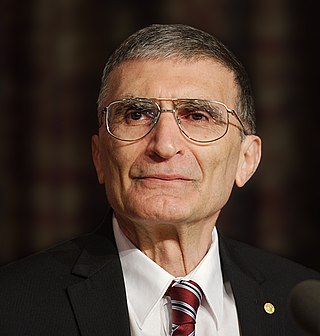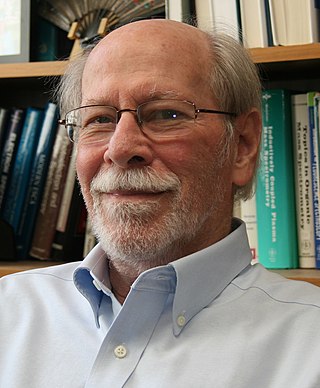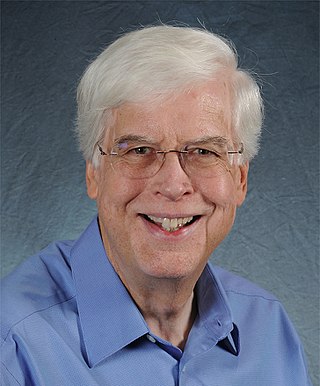
The University of North Carolina at Chapel Hill is a public research university in Chapel Hill, North Carolina. After being chartered in 1789, the university first began enrolling students in 1795, making it one of the oldest public universities in the United States.

Gerald J. Meyer is an active researcher and professor of inorganic chemistry at the University of North Carolina at Chapel Hill. He was previously the Bernard N. Baker Chair In Chemistry at Johns Hopkins University. His research interests include inorganic photochemistry with emphasis on solar energy, using interfacial electron transfer processes and dye-sensitized solar cells.

Aziz Sancar is a Turkish molecular biologist specializing in DNA repair, cell cycle checkpoints, and circadian clock. In 2015, he was awarded the Nobel Prize in Chemistry along with Tomas Lindahl and Paul L. Modrich for their mechanistic studies of DNA repair. He has made contributions on photolyase and nucleotide excision repair in bacteria that have changed his field.

Henry Fuchs is a fellow of the American Academy of Arts and Sciences (AAAS) and the Association for Computing Machinery (ACM) and the Federico Gil Professor of Computer Science at the University of North Carolina at Chapel Hill (UNC). He is also an adjunct professor in biomedical engineering.

Renaissance Computing Institute (RENCI) was launched in 2004 as a collaboration involving the State of North Carolina, University of North Carolina at Chapel Hill (UNC-CH), Duke University, and North Carolina State University. RENCI is organizationally structured as a research institute within UNC-CH, and its main campus is located in Chapel Hill, NC, a few miles from the UNC-CH campus. RENCI has engagement centers at UNC-CH, Duke University (Durham), and North Carolina State University (Raleigh).

Joseph M. DeSimone is an American chemist, inventor, and entrepreneur who has co-founded companies based on his research, including the American 3D printing technology company, Carbon, of which he was CEO from 2014 until November 2019.
Laurie Ann Paul is a professor of philosophy and cognitive science at Yale University. She previously taught at the University of North Carolina at Chapel Hill and the University of Arizona. She is best known for her research on the counterfactual analysis of causation and the concept of "transformative experience."
A Microraft (Isoraft) is an arrays of microwells for cell sorting, isolating cells, analyzing cells over time, and generating clonal populations. This platform provides biomedical scientists with access to diverse cell culture surfaces with integrated, easy-to-use cell separating capabilities at low cost.
The Beckman Young Investigators Award was established by Mabel and Arnold Beckman in 1991, and is now administered by the Arnold and Mabel Beckman Foundation. The Beckman Young Investigator (BYI) Program is intended to provide research support to promising young faculty members in the early stages of their academic careers. Awardees receive grant of roughly $600,000 over four years, "contingent on demonstrated progress after the second year". The intent is to foster "innovative departures" and the invention of methods, instruments and materials that will open up new avenues of research in the chemical and life sciences.

Valerie Sheares Ashby is an American chemist and university professor who currently serves as president of the University of Maryland, Baltimore County. She was the Dean of Trinity College of Arts and Sciences at Duke University from 2015 to 2022 and formerly chair of the chemistry department at the University of North Carolina at Chapel Hill from 2012 to 2015. With her research group, she holds ten patents. On April 4, 2022, it was announced that Ashby would assume the position of president of the University of Maryland, Baltimore County.

Royce W. Murray was an American chemist and chemistry professor at the University of North Carolina at Chapel Hill. His research interests were focused on electrochemistry, molecular designs, and sensors. He published over 440 peer-reviewed articles in analytical, physical, inorganic, and materials chemistry, and trained 72 Ph.D students, 16 master’s students, and 58 postdoctoral fellows, 45 of whom have gone on to university faculty positions. He was named a fellow of the American Chemical Society in 2012, and was the inventor on three patents related to surface-modified electrodes.
Mark H. Schoenfisch is an American analytical chemist. He is the Peter A. Ornstein Distinguished Professor of Chemistry at the University of North Carolina at Chapel Hill and is jointly appointed with the institution's Schools of Medicine and Pharmacy. His research interests include analytical sensors, biomaterials, and the development of macromolecular nitric oxide release scaffolds as novel therapeutics. Intellectual property originating from his research group is the basis of technology being commercialized by Novan, Diabetic Health, and Vast Therapeutics located in the Research Triangle Park.

Robert Mark Wightman is an electrochemist and professor emeritus of chemistry at the University of North Carolina at Chapel Hill. He is best known for his work in the areas of ultramicroelectrodes, electrochemistry, and neurochemistry. One of Wightman's most notable achievements is the development of the ultramicroelectrode and microelectrode voltammetry. At the same time as Wightman's innovations, the microelectrode was developed independently by Martin Fleischmann at the University of Southampton. In 2011, Wightman had the 192nd highest h-index, 74, of any living chemist. As of 2018, Wightman was an author of over 390 papers and had an h-index of 103.
John Michael Ramsey is an American analytical chemist at the University of North Carolina at Chapel Hill. He currently holds the position of Minnie N. Goldby Distinguished Professor of Chemistry. His current research with the university focuses on microscale and nanoscale devices such as microchip electrospray, microscale Ion trap mass spectrometers, and microfluidic point of care devices. He is ranked #2 in the "Giants of Nano" field on The Analytical Scientist Power List.

Elizabeth Wayne is an Assistant Professor of Biomedical Engineering and Chemical Engineering at Carnegie Mellon University and former Postdoc at the Center for Nanotechnology in Drug Delivery at the University of North Carolina at Chapel Hill. Wayne was a 2017 TED fellow and is a member of a number of professional societies, including the National Society of Black Physicists.

Gary Glish is an American analytical chemist at the University of North Carolina at Chapel Hill. He is a leading researcher in the fields of mass spectrometry, ion chemistry, and biomolecule analysis.

James Wallace Jorgenson is an American academic who previously held the position of William Rand Kenan Jr. Distinguished Professor of Chemistry at UNC-Chapel Hill. He is best known for his work developing capillary zone electrophoresis, and is a member of the American Academy of Arts and Sciences.
Frances S. Ligler is a biochemist and bioengineer who was a 2017 inductee of the National Inventors Hall of Fame. Ligler's research dramatically improved the effectiveness of biosensors while at the same time reducing their size and increasing automation. Her work on biosensors made it easier to detect toxins and pathogens in food, water, or when airborne.

Marcey Lynn Waters is the Glen H. Elder Jr., Distinguished Professor of Chemistry at the University of North Carolina, Chapel Hill (UNC-CH). She is an organic chemist whose research is at the interface of chemical biology and supramolecular chemistry. Waters has received multiple awards for research, teaching, and advocating for women in science. She is serving the President of the American Peptide Society (APS) from 2017 to 2019.
Steven Alan Soper is an American biomedical engineer who currently serves as the director of the NIH-funded, Center of BioModular Multiscale Systems for Precision Medicine (CBMM). He has served as a professor at the Universities of North Carolina – Chapel Hill, Louisiana State University and is currently a Foundation Distinguished Professor in Mechanical engineering, Chemistry, and Bioengineering at the University of Kansas. He also holds adjunct positions in the Department of Cancer Biology and the Department of Biomedical Engineering at Ulsan National Institute of Science and Technology. He is the founder of the biotechnology company, BioFluidica, Inc.













